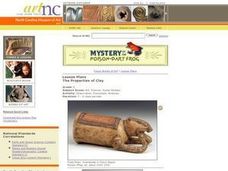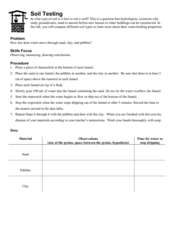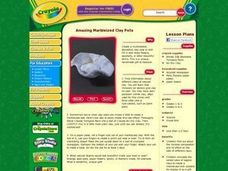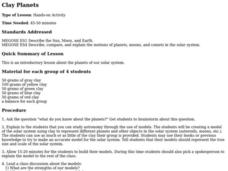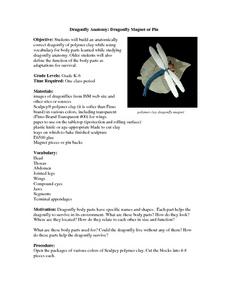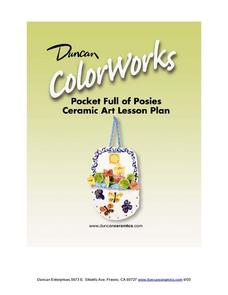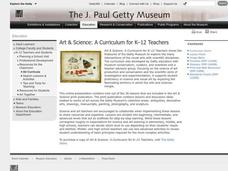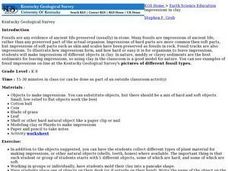Curated OER
Paper Clay Leaves
Using real leaves to imprint clay, your class will see a natural effect on their individual projects. This is a fabulous way to study leaf anatomy in science. Or, you can focus on mixing colors to recreate the original. These leaves can...
Curated OER
The Properties of Clay
Sixth graders determine the physical properties of clay by examining ceramic works of art. They evaluate local soil samples for suitability for sculpting and compare clay taken from soil to manufactured clay.
Curated OER
Soil Testing
Earth science learners experiment with the water-holding properties of sand, pebbles, and clay. They apply their findings to the building of a well. This activity is engaging and tactile, and it demonstrates the importance of considering...
Curated OER
Clay
What is made from clay? First graders draw and illustrate four objects or things that are made out of clay. They then list two more things made out of clay in the box provided.
Curated OER
Amazing Marbleized Clay Pots
Learners discover information about different colors of natural clay, finding that mineral composition has its effect on the color of different clays. They simulate the varied colors of organic clays to create a marbleized dish suitable...
University of Alaska
Clay Model Earth
What a great way to incorporate hands-on learning while teaching about the earth's layers. The class observes an overhead transparency (linked in Included Materials) as they create their own model Earth using different colors of clay....
Curated OER
Clay Planets
Have your class learn about the solar system using this hands on technique. Learners review what they know about the planets, and create a clay model of the solar system. There are a list of resource links to make this lesson a complete...
Teach Engineering
Clay Boats
Clay itself sinks, but clay boats float. Why? Young engineers build clay boats to learn about buoyancy. They test the weight the boats can hold using washers and then tweak their designs to make improvements, following the engineering...
Curated OER
Clay Planets
Students create scale models of the planets out of clay and compare them to the real planets.
Curated OER
Clay Sculpture: Relationships
Students explore art history by conducting an in-class activity. In this sculpting lesson, students examine previously created art sculptures in a textbook. Students utilize clay, sculpting tools and grey paper to create their own...
Curated OER
Activity: Float a Clay Boat
Written to introduce pupils to buoyancy, this activity has collaborative groups work to design a floatable clay boat. They first observe that a stick of clay sinks in water and then are given their own stick to reshape into a floating...
Curated OER
Dragonfly Anatomy: Dragonfly Magnet or Pin
Students build anatomically correct dragonflies of polymer clay, use vocabulary for body parts, and define the function of the body parts as adaptations for survival.
Curated OER
Edible Soils
Students create soil profiles, including rock, clay, silt, sand, and humus, in clear plastic cups out of edible materials.
Curated OER
Digital Mitosis and Claymation
Take mitosis and meiosis out of the biology textbook and onto the screen! An innovative class project prompts young biologists to create an animation movie using clay, showing the phases involved in mitosis or meiosis by...
University of Colorado
Clay Planets
Why do scientists use models? In the first installment of 22, groups create scale models of our solar system. They then share and discuss their models.
Curated OER
Pocket Full of Posies: Ceramics
After studying the plant or flower life cycle, have the class create a basket of flowers out of clay. They hone their ceramics skills while they push, pull, then paint clay to look like flowers they've seen in nature. There are several...
Curated OER
Starfish Project: Ceramics
After exploring the wonders of ocean life found in tidal pools, explore ocean life through ceramic art. Kids use texturing and the pinch-and-pull technique to create starfish, just like the ones found at the seashore. Suggested...
Curated OER
Clay Ants: Insect Anatomy
Students examine anatomic structures in order to identify insects from other living organisms. They gain a level of comfort from anxiety when observing and handling live and pinned insects. They create clay models of an insect.
Curated OER
The Chemistry of Ceramics
Students compare the characteristics of a fired porcelain sculpture to the clay used to create it. They discuss the physical and chemical changes that occur in the clay as it is heated and then create their own clay sculpture. This...
Curated OER
Impressions in Clay
Students examine how fossils are created. They make impressions of different objects in clay and compare them to examples of fossils.
Curated OER
Clay Atoms-Taming Our Fear Of The Invisible
Students create atoms with clay by using different colors to represent the protons, neutrons and nucleus. In this creative lesson students use clay to learn about atoms and see how they apply to the periodic table.
Curated OER
Animal Adults and Babies
Students examine how different animals care for their young and how young animals change as they grow. They conduct research on the growth patterns and life cycle of a selected animal, create a realistic baby and adult form of their...
Curated OER
Our Chicks Are Hatching!
Young scholars examine the incubation and hatching process for chicks in photographs or with real-life chicks in the classroom. They identify the different stages of the hatching process, and create sculptures of hatching chicks using clay.
Curated OER
Sand Shakes & Mud Pies: Investigating Sediment
Take a field trip to a location where water and land meet to study patterns of sediment organization in wet habitats: river or ocean beaches, sand dunes, tidal marshes, the edge of a pond, or a woodland stream. Small groups collect pairs...
Other popular searches
- Clay Modeling
- Clay Modeling Sea Stars
- Clay Modeling Sculpture
- Clay Modeling Planets
- Clay Modeling Horses
- Clay Modeling Communities
- Clay Modeling Pigs
- Clay Modeling and Bartholdi



